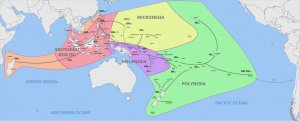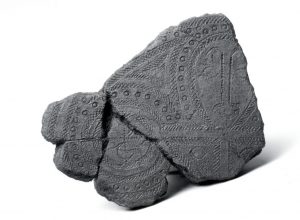15 The Pacific’s first navigators
European explorers, working at the limits of their technology and pushing beyond the edges of their known world, were regularly startled to find Polynesians already inhabiting the islands they had only just been able to reach. The term ‘Polynesia’ is a European one, and it reflects the experience of the European explorers who recognised that the people they encountered in this watery section of the planet shared elements of culture and language. Startled that other people could navigate the region earlier and more thoroughly than they had yet managed themselves, Europeans speculated on how the Polynesians had arrived. Interest in that story of human discovery continues and the story of the original exploration of the Pacific is continually being refined by archaeologists.
Early European explorers were perplexed by the presence of Polynesians on widely scattered islands and sought to explain it. In 1722, Dutch explorer Jacob Roggeveen raised the possibility that the inhabitants of Rapa Nui (Easter Island) had been created there or otherwise directly placed there by God. Europeans, struggling to reliably reach previously visited Pacific Islands, also tended to discount the navigational abilities of Islanders, leading to the enduring idea that the Pacific Islands had been discovered and settled by survivors of vessels blown off course and out to sea. In the nineteenth century there was also some enthusiasm for the idea that the islands of Polynesia were the remnants of a sunken continent which had left only its mountaintops above sea level, holding survivors of a lost civilisation. Some early observers put forward the idea that Polynesians had migrated from Asia, an idea familiar in the present. During the nineteenth century, migration theories proliferated and variously suggested Aryan, European, and Semitic origins for Polynesians, as well as raising the prospect of waves of migration by different peoples across the Pacific at different times. The possibility of a South American origin for Pacific migration was also put forward, supported by biological evidence (in the form of sweet potatoes) of pre-European contact between Oceania and the Americas.

The development of the discipline of archaeology has changed the way in which the question of Polynesian origins is addressed, as have improved understandings of the ways in which the world itself has changed over time (the prospect of a sunken continent has been destroyed). When human beings first set out into the Pacific the region was physically different from the way it is now. Lower sea levels made the region more accessible from the west, and large amounts of evidence has led archaeologists to believe that the ancestors of Pacific Islanders came from southeast Asia. Approximately 30,000 years ago, when sea levels were at their lowest, people settled the Bismarck Archipelago and the northern Solomon Islands. Low sea levels had made those regions more accessible, and people arrived.
About 26,000 years ago sea levels began to rise with global temperatures, and about 3,500 years ago a new phase of Pacific exploration began. This was a distinct phase of Pacific exploration, as rising sea levels had made islands smaller, and distances between them greater. Despite these challenges, people reached the islands of western Polynesia, and archaeologists associate this period with a range of artefacts that they think come from a distinct culture. The Lapita people are named after the archaeological site at which their distinctive pottery was first found, and further Lapita sites have been located within Oceania. Archaeologists have identified variations in decorative motifs and artefacts between remains at western and eastern Lapita sites, and between remains from different time periods. Lapita artefacts seem to have stopped being made about 2,000 years ago. Archaeologists find Lapita remains exciting because they indicate the existence of cultural connections across a wide swathe of the Pacific, and because they are traces of people who travelled out into the Pacific even when the land they were heading towards was out of sight over the horizon. Quite who the Lapita were, and what their connections with present-day Pacific Islanders might be, remains unclear, but their presence in the Pacific is part of the human history of the exploration of that ocean.

The Lapita did not reach beyond western Polynesia, and archaeologists have two sets of theories about how the remaining expanses of ocean were settled. One school of thought holds that people took an ‘express train’, directly from south China or Taiwan to the far reaches of Oceania, while the other holds that people travelled by a ‘slow boat’ in a process involving populations moving in multiple directions and cultural mixing occurring between culturally distinct populations. These theories are supported by various types of evidence: linguistic, physical remains, and more recently genetic evidence, including analysis of genetic material belonging to the non-human species that travelled with the Pacific’s first explorers. The ongoing debate about the details of human migration to the far reaches of Polynesia demonstrates that interest in Polynesian origins remains strong. But, while details remain unclear, there is general agreement about the Asian origins of the Pacific’s first people, and about the times they arrived at the different island groups of the Pacific.
The story of the original exploration of the Pacific is told by archaeologists rather than historians. As a result, it is a grand story of human endeavour, and lacks the presence of individual people making decisions or engaging with their environments. That is the nature of archaeology: it can reveal the actions of societies and guess at their communal beliefs and concerns, but without written texts it cannot reveal the actions and thoughts of individuals. Archaeologists engage with past societies through the physical traces they leave behind, and those traces are often things that have been deliberately discarded (rubbish). This approach allows archaeologists to voyage into parts of the past that historians cannot visit and go beyond the written record, but it limits what they can detect there.
The journals, maps, and other records created during the European exploration of the Pacific capture only parts of the last 500 years of the Pacific’s past. However, those written sources allow us to peer inside the minds of the explorers themselves, and to catch glimpses of island societies as Europeans first encountered them. Historical sources, like the sources used by archaeologists, only offer glimpses of the past, but those glimpses are fascinating and valuable for understanding both Islander and European perspectives of the events unfolding, and for offering chances to step inside the minds of people in the past. Archaeological techniques can take us further back into the past, but they can cast only limited light on the first human exploration of the Pacific Ocean.
Links
Video material
Open access secondary sources
Bedford, Stuart, Robert Blust, David V. Burley, Murray Cox, Patrick V. Kirch, Elizabeth Matisoo-Smith, Ashild Naess, Andrew Pawley, Christophe Sand, and Peter Sheppard. “Ancient DNA and its Contribution to Understanding the Human History of the Pacific Islands.” Archaeology in Oceania 53, (2018): 205–219. https://doi.org/10.1002/arco.5165
Bedford, Stuart, Christophe Sand, and Sean P. Connaughton (eds). Oceanic Explorations: Lapita and Western Pacific Settlement. Canberra: ANU Press, 2007. http://doi.org/10.22459/TA26.2007
Matisoo-Smith, Lisa, Anna Gosling. “Did Ancient Americans Settle in Polynesia? The Evidence doesn’t Stack Up.” The Conversation, July 13, 2020. https://theconversation.com/did-ancient-americans-settle-in-polynesia-the-evidence-doesnt-stack-up-142383
Other secondary sources
Belich, James. Making Peoples: A History of the New Zealanders from Polynesian Settlement to the End of the Nineteenth century. Honolulu: University of Hawai’i Press, 1996.
Eisenhofer, Raphael, Atholl Anderson, Keith Dobney, Alan Cooper & Laura S. Weyrich. “Ancient Microbial DNA in Dental Calculus: A New Method for Studying Rapid Human Migration Events.” The Journal of Island and Coastal Archaeology 14, no. 2 (2019): 149-162.
Thompson, Christina. Sea People: The Puzzle of Polynesia. London: William Collins, 2019.

